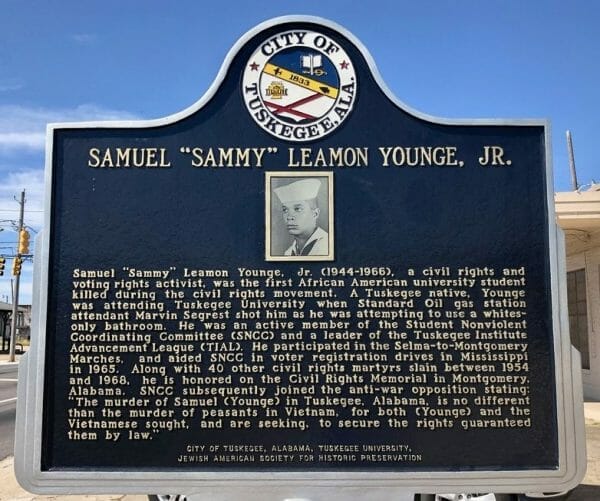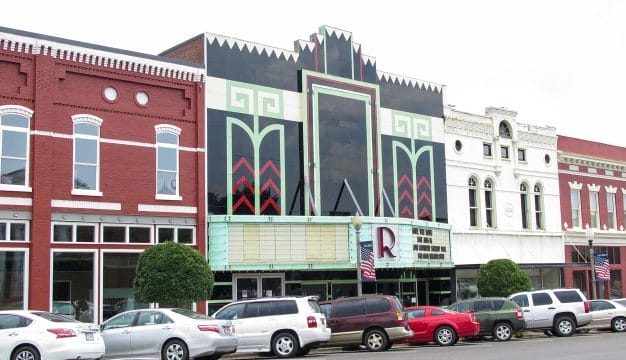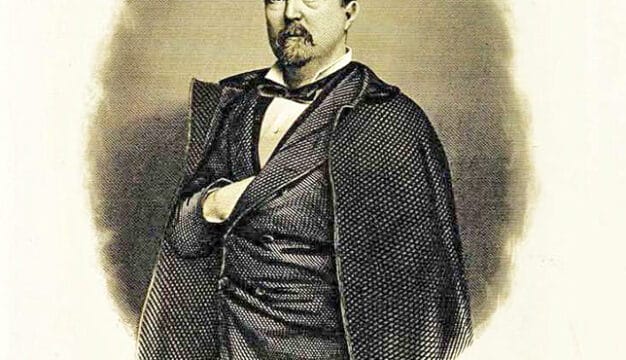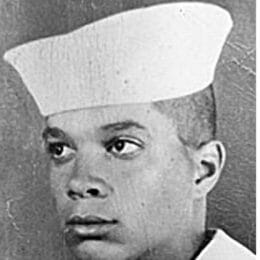Samuel Younge Jr.
Tuskegee Institute student Samuel Younge Jr. (1944-1966) was the first black college student to be killed as a result of his involvement in the American civil rights movement. During the mid-1960s, Younge worked to desegregate public facilities and led voter-registration drives in Macon County and in other parts of the South. His violent death in 1966 for trying to use a whites-only restroom inspired civil rights workers in Alabama and throughout the nation to continue their work for racial equality and pushed the Student Nonviolent Coordinating Committee (SNCC) to publicly oppose American involvement in the Vietnam War.
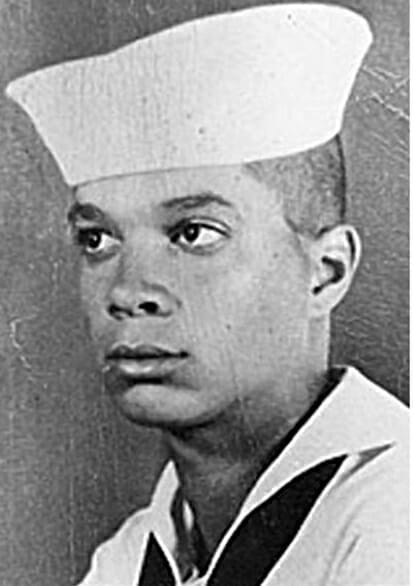 Samuel Younge Jr.
Samuel “Sammy” Leamon Younge Jr. was born on November 17, 1944, in Tuskegee to middle-class parents Samuel and Renee Younge and was the first of two children. Although he spent two years attending the Cornwall Academy in Massachusetts, Younge spent most of his academic career attending public schools in Tuskegee. After graduating from Tuskegee Institute High School in 1962, Younge enlisted in the United States Navy. He served on the USS Independence, an aircraft carrier that participated in the 1962 U.S. blockade of Cuba. Younge suffered from a failed kidney following his first months of service and had it removed in surgery. As a result of his condition, he was given a medical discharge from the Navy in July 1964 and returned to Tuskegee. After a stint working at the Tuskegee Veteran’s Hospital, Younge enrolled at the Tuskegee Institute in January 1965.
Samuel Younge Jr.
Samuel “Sammy” Leamon Younge Jr. was born on November 17, 1944, in Tuskegee to middle-class parents Samuel and Renee Younge and was the first of two children. Although he spent two years attending the Cornwall Academy in Massachusetts, Younge spent most of his academic career attending public schools in Tuskegee. After graduating from Tuskegee Institute High School in 1962, Younge enlisted in the United States Navy. He served on the USS Independence, an aircraft carrier that participated in the 1962 U.S. blockade of Cuba. Younge suffered from a failed kidney following his first months of service and had it removed in surgery. As a result of his condition, he was given a medical discharge from the Navy in July 1964 and returned to Tuskegee. After a stint working at the Tuskegee Veteran’s Hospital, Younge enrolled at the Tuskegee Institute in January 1965.
Younge joined the civil rights movement during his first semester at the school. He was involved in the Tuskegee Institute Advancement League (TIAL), a campus civil rights group organized by students with the help of the Tuskegee chapter of SNCC the previous fall. As a member of TIAL, he helped organize a variety of civil rights and protest activities. On March 10, 1965, he was among the hundreds of demonstrators at the state capitol in Montgomery who protested the beating of those involved in the Selma to Montgomery march on the day often referred to as “Bloody Sunday.” The following April, Younge travelled to Mississippi to help SNCC and the Mississippi Freedom Democratic Party register black voters and also worked to register voters in rural areas near Tuskegee, including Brownsville. During the rest of the year, he and the other TIAL members continued voter-registration efforts and also pushed for the desegregation of restaurants, public schools, pools, and churches in Tuskegee, often at the risk of their own personal safety. At one particular demonstration on July 18, 1965, Younge and approximately 30 other individuals were attacked by a mob of whites for trying to desegregate a Tuskegee church. That September, Younge was arrested in Opelika, along with six other TIAL students, while attempting to transport individuals to register to vote in Lee County.
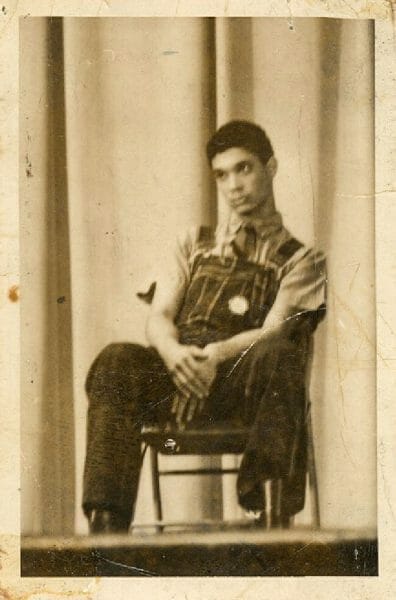 Samuel Younge Jr. at Tuskegee
Four months later, Younge was again working a voter-registration drive in Macon County. On January 3, 1966, after he tried to use the whites-only bathroom at a Standard Oil gas station, Younge was shot and killed by attendant Marvin Segrest. In the days following his death, thousands marched through the streets of Tuskegee in outrage over the treatment of blacks within the city. Despite the demonstrations, Segrest was not indicted for Younge’s murder until November 1966 and was found innocent by an all-white jury the following month. Younge’s death also spurred action from SNCC, which called a press conference on January 6, 1966, to declare its opposition to the war in Vietnam, the first statement of its kind by a civil rights organization. Younge’s death was highlighted at the press conference as an example of the hypocrisy of fighting for freedom abroad while rights were denied in the United States and was used as a call for people to refuse the draft and work for freedom at home instead.
Samuel Younge Jr. at Tuskegee
Four months later, Younge was again working a voter-registration drive in Macon County. On January 3, 1966, after he tried to use the whites-only bathroom at a Standard Oil gas station, Younge was shot and killed by attendant Marvin Segrest. In the days following his death, thousands marched through the streets of Tuskegee in outrage over the treatment of blacks within the city. Despite the demonstrations, Segrest was not indicted for Younge’s murder until November 1966 and was found innocent by an all-white jury the following month. Younge’s death also spurred action from SNCC, which called a press conference on January 6, 1966, to declare its opposition to the war in Vietnam, the first statement of its kind by a civil rights organization. Younge’s death was highlighted at the press conference as an example of the hypocrisy of fighting for freedom abroad while rights were denied in the United States and was used as a call for people to refuse the draft and work for freedom at home instead.
Samuel Younge, in life and in death, represented the struggle for black freedom in Alabama in the 1960s. In his short life, he worked to break down barriers of inequality by registering black voters and pushing for the desegregation of public facilities. It was this work that ultimately cost him his life and made him a martyr for the civil rights movement in Alabama and the rest of the nation, inspiring countless others to take up the cause of racial equality in the United States.
Further Reading
- Carson, Clayborne. In Struggle: SNCC and the Black Awakening of the 1960s. Cambridge: Harvard University Press, 1981.
- Forman, James. Sammy Younge, Jr.: The First Black College Student to Die in the Black Liberation Movement. New York: Grove Press, 1968.
